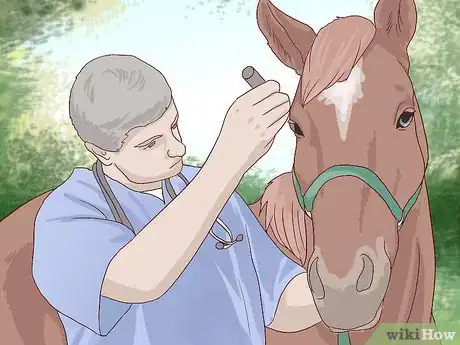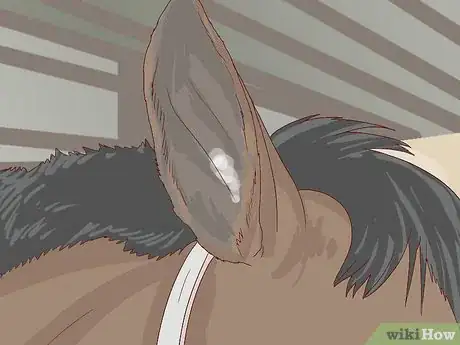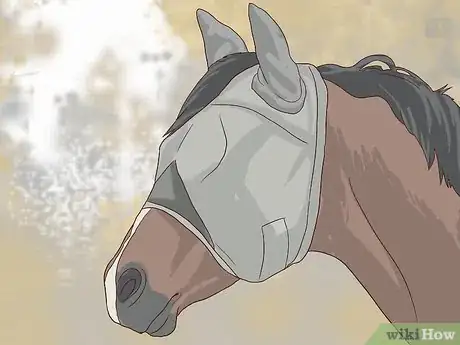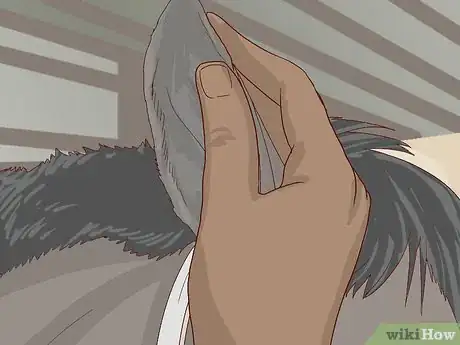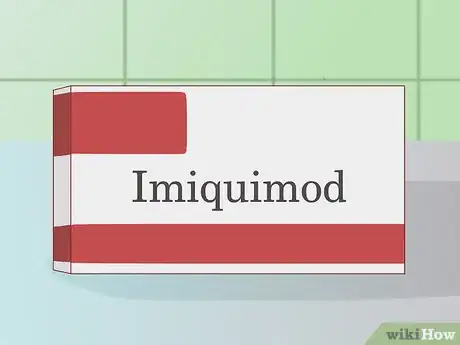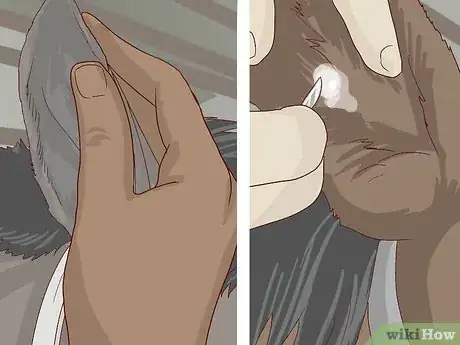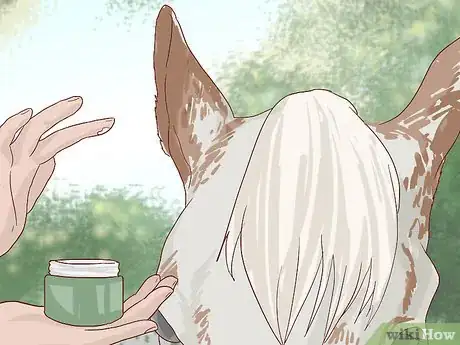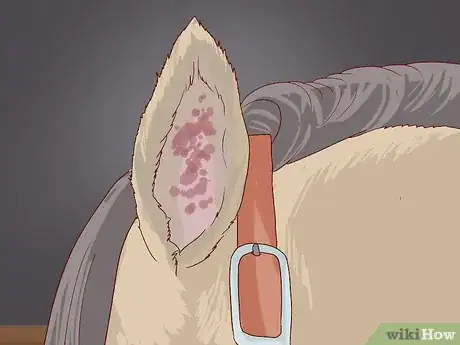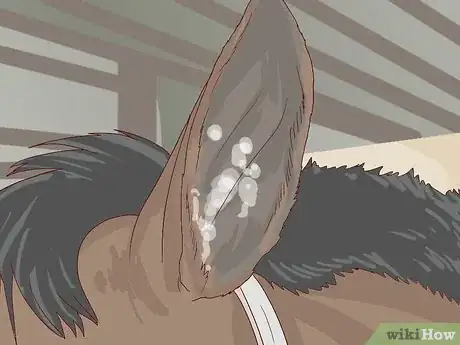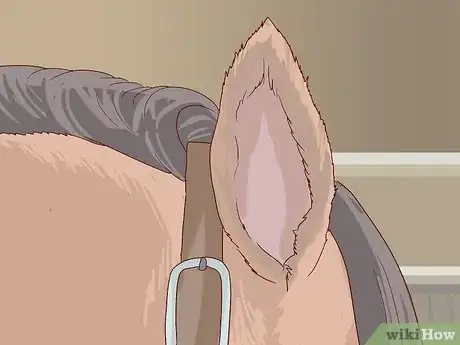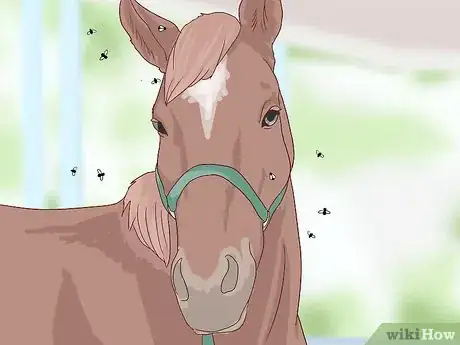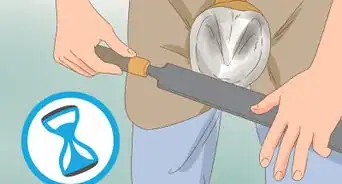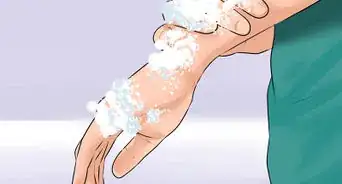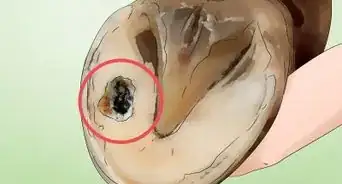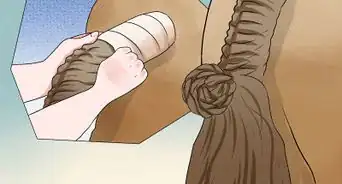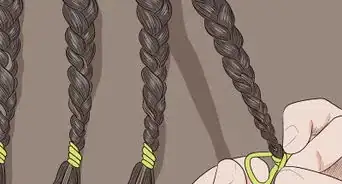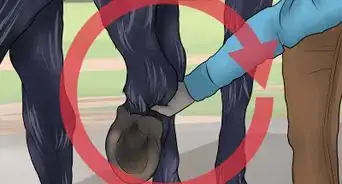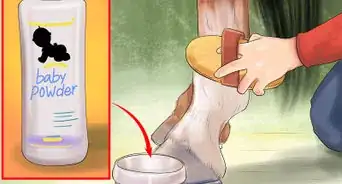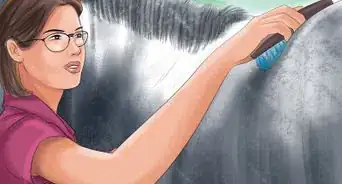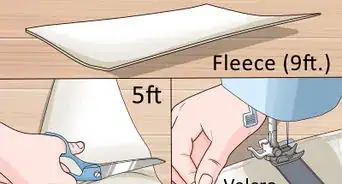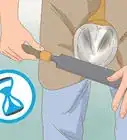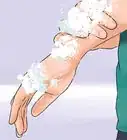This article was co-authored by Ryan Corrigan, LVT, VTS-EVN. Ryan Corrigan is a Licensed Veterinary Technician in California. She received her Bachelor of Science in Veterinary Technology from Purdue University in 2010. She is also a Member of the Academy of Equine Veterinary Nursing Technicians since 2011.
There are 9 references cited in this article, which can be found at the bottom of the page.
This article has been viewed 32,368 times.
Ear or aural plaque is a common condition in horses. It causes crusty white patches inside the ear. Most of the time, ear plaque isn’t harmful and is just a cosmetic issue. Common treatment is preventing flies from biting the horse and leaving it alone, but if your horse’s ears become painful, you can contact your vet and try a cream to treat the ear plaque.
Steps
Treating Ear Plaque Cautiously
-
1Contact your vet. If you believe that your horse has aural plaque, contact your veterinarian. An examination will confirm that the whitish, flaky sections are in fact ear plaque and not another more serious condition. Your vet will also suggest a course of treatment.[1]
- Your vet may suggest that you do nothing to treat the plaque. They may also suggest a cream or ask you to bring the horse in so the plaque can be gently shaved off under sedation.
- Make sure to never remove a plaque or apply a cream to the horse’s ears without consulting the vet first.
-
2Leave the ear plaque alone. Many veterinarians suggest no treatment for aural plaque in horses. Ear plaques do not bother all horses, so for many horses it is just a cosmetic issue that bothers the owner. Touching or handling the ears may cause more problems for the horse than leaving it alone.[2]
- Too much handling of the horse’s ears when they have ear plaque may cause them to be head shy or sensitive to people being around their ears or face.
Advertisement -
3Prevent flies from biting your horse. To help your horse from getting infected or reinfected, find ways to get rid of flies around the horse. You may use a fly repellent spray to keep the flies away. You can try a fly mask with ears.[3] You may also consider placing the horse in a stable during the times when flies are active, which is dawn and dusk.[4]
- This can also reduce your horse’s discomfort because when flies bite the sensitive, infected ears, it can irritate the existing ear plaque that may not hurt or bother the horse otherwise.
-
4Discuss any scrubbing or scraping of the ears with your vet. If the ear plaque isn’t bothering your horse, you shouldn’t worry about trying to remove the patches of plaque. This can cause more pain for the horse, and increase their ear and head sensitivity. If your horse is in pain, you can discuss with your vet about removing the plaque.[5]
- If you want to remove the plaque, try softening the scaly patches with baby oil first. Baby wipes are also good for cleaning the ears and removing the flaky debris of aural plaques. Remove the plaque as gently as possible.
- You can treat the red, pink areas left by the ear plaque with healing ointments. Talk to your vet about a proper ointment to help heal the affected areas.
Treating Ear Plaque with Wart Cream
-
1Consider using a wart cream. Many vets have started using imiquimod (Aldara), a human wart cream, to treat aural plaque.[6] The cream treats the plaques in many horses when using a 5% solution, by stimulating an immune response in the affected area.[7] This treatment is primarily used if the ear plaque is causing problems or pain for the horse.
- Some horses and cases of ear plaque won’t respond to imiquimod.
-
2Prepare the ear before using the cream. Before using the cream, you have to remove the white crusty areas and any other build up on the ears.[8] To remove the ear plaque, use baby oil or another agent to soften the crusty, flaky areas first. Then, carefully and as gently as possible, remove the crusts.[9]
- Never scrape the flakes off the horse's ear without softening it first. You don't want to cause the horse any additional pain. Scraping the plaque off the ears without taking care to reduce pain can cause head shyness and resistance.
-
3Apply the cream three times each week or as directed. Talk to your vet about the recommended treatment schedule for your horse. Generally, the cream is applied every other day for a few months.[10] Some horses may only need to be treated every other week, however. Be sure to follow your vet’s directions in applying the cream. [11]
- If your horse is in a lot of pain, your vet may recommend applying the cream twice weekly instead.
-
4Be aware of the side effects of the cream. The wart cream can lead to reactions in some horses. The most common reaction is severe inflammation. The affected areas may become red, start swelling, or ooze.[12]
- Some horses may have to be sedated. If the side effects are too much for your horse, your vet may prescribe Phenylbutazone. This is non-steroidal anti-inflammatory (NSAID) that helps with pain and inflammation. [13]
- Don’t stop treatment because of side effects – consult with your vet, instead. By stopping early, you may end up losing valuable progress in healing.
Identifying Aural Plaque
-
1Check for a white substance in the ear. The main symptom of ear plaque in horses is white or pale grey growths in the ear. They may appear crusty or flaky. It may be in small bumps or in large patches.[14] The whitish patches are often slightly raised.[15]
- Aural plaques are often described as looking like small cauliflower.
-
2Look at the skin underneath the white substance. If your horse has ear plaque, the skin underneath the white, crusty patch will be shiny and pink or red. This will look different than what the inside of your horse’s ear usually looks like.[16]
-
3Notice any ear or head shyness. Horses who have ear plaque may act shy, skittish, or irritated if their ears are touched. Aural plaques can cause ear sensitivity that leads to horses not liking having anything done to their ears or heads. This may cause the horse not to want to be bridled or have a halter put on.[17]
- Some horses may display head shaking due to ear plaque.[18]
- Some horses won’t be bothered by the ear plaques and their ears will not be sensitive.
-
4Figure out if your horse’s ears have been bitten by flies. Ear plaque is common in horses. Some horses are more prone to it than others, and some horses may not get it at all. Ear plaque is commonly spread by bites from flies.[19]
- Aural plaque is believed to be caused by a wart virus similar to one that causes warts in young horses.
References
- ↑ https://www.vetmed.umn.edu/centers-programs/clinical-investigation-center/completed-clinical-studies/veterinarian-instructions-aldara
- ↑ https://www.vetmed.umn.edu/centers-programs/clinical-investigation-center/completed-clinical-studies/aldara-faq
- ↑ https://www.smartpakequine.com/content/aural-plaques
- ↑ http://www.merckvetmanual.com/mvm/eye_and_ear/diseases_of_the_pinna/equine_aural_plaques.html
- ↑ http://www.petmd.com/horse/conditions/skin/c_hr_aural_plaque#
- ↑ https://www.vetmed.umn.edu/centers-programs/clinical-investigation-center/completed-clinical-studies/aldara-faq
- ↑ http://www.thehorse.com/articles/37780/could-a-cream-eliminate-equine-aural-plaques
- ↑ http://novickdvm.com/auralplaques.htm
- ↑ https://www.vetmed.umn.edu/centers-programs/clinical-investigation-center/completed-clinical-studies/aldara-faq
- ↑ https://www.vetmed.umn.edu/centers-programs/clinical-investigation-center/completed-clinical-studies/aldara-faq
- ↑ http://www.merckvetmanual.com/mvm/eye_and_ear/diseases_of_the_pinna/equine_aural_plaques.html
- ↑ http://novickdvm.com/auralplaques.htm
- ↑ https://www.vetmed.umn.edu/centers-programs/clinical-investigation-center/completed-clinical-studies/aldara-faq
- ↑ http://www.proequinegrooms.com/index.php/tips/grooming/aural-plaques/
- ↑ http://www.horsetalk.co.nz/news/2009/07/003.shtml#axzz4MEgv9JBi
- ↑ http://www.proequinegrooms.com/index.php/tips/grooming/aural-plaques/
- ↑ http://www.horsetalk.co.nz/news/2009/07/003.shtml#axzz4MEgv9JBi
- ↑ http://www.petmd.com/horse/conditions/skin/c_hr_aural_plaque#
- ↑ http://novickdvm.com/auralplaques.htm
About This Article
To get rid of ear plaque in horses, contact your vet, who may advise that you leave it alone since handling the ears can cause more problems. If the ear plaque is causing your horse discomfort, discuss removing it with your vet. Your vet may recommend softening the scales with baby oil and use a baby wipe to clean the plaque off. Additionally, your vet may recommend applying wart cream to your horse’s ears for several weeks. For more tips from our Veterinary co-author, including how to recognize ear plaque in your horse, keep reading!
